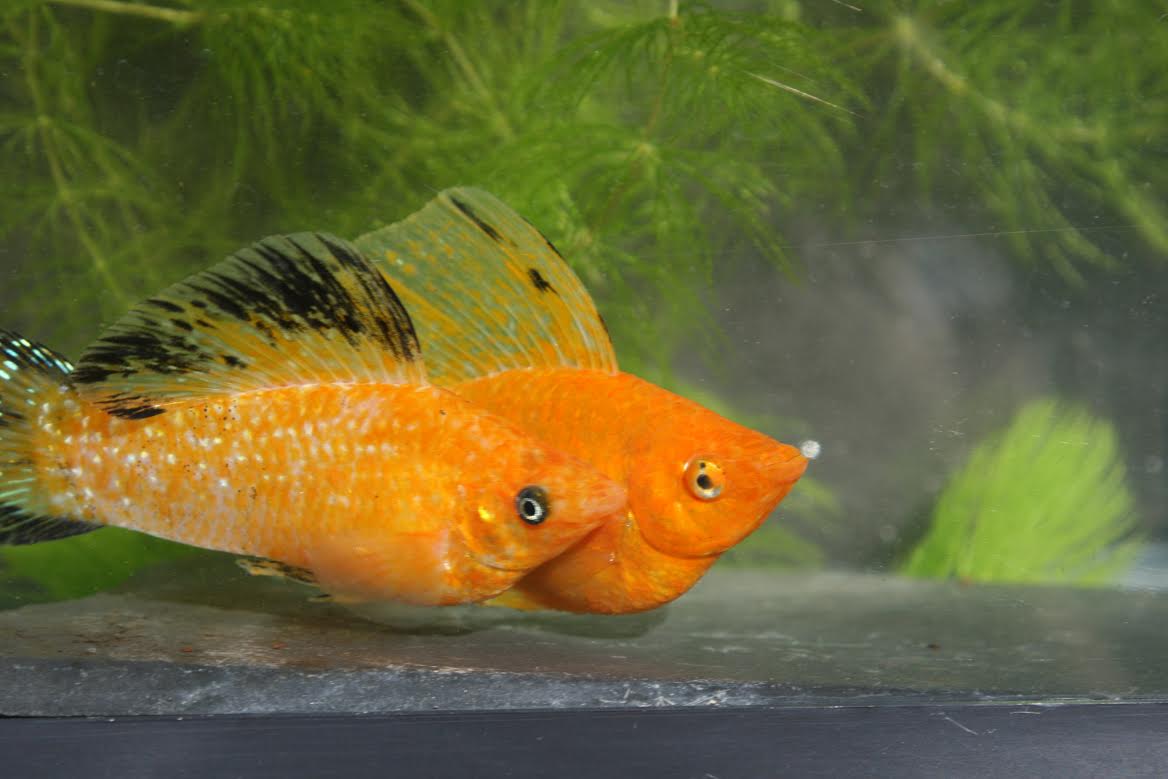To salt or not to salt, that is the question…
I often get asked about mollies and salt. Typical of this question is what Mandee Widrick Flanders wrote on our Facebook page:
“Hi Ash & Goliad Farms, As someone who is relatively new to keeping sailfin mollies (about 6 months in), I’ve heard a lot of debate about keeping them in freshwater vs brackish water. I’m curious which you find your sailfins to thrive in. I currently have mine in freshwater with a pH of about 8.2 and use cichlid lake salt to increase water hardness as my tap water is very soft. They seem to do well with these parameters, though I do run into fungal issues from time to time and I wonder if brackish water would help prevent this. Would love to hear your opinion on fresh vs brackish when you have a few minutes. Thanks! Mandee”
First, “Ash” is Ashley, our hatchery technician responsible for livebearers. Ashley booted this question to me.
Okay, Mandee, here goes. I’ve found salt to be completely optional for keeping mollies, including the sailfin mollies. First, a bit about “sailfin” mollies. There are three wild species in the genus Poecilia, which include mollies and guppies. These are P. latipinna, our native molly; P. petenensis, from southern Mexico and Central America; and P. velifera, from Yucatan, Mexico. All the other mollies are considered short finned mollies. However, there are many commercial (also called domestic) molly strains resulting from hybridization among the three wild sailfins and some of the short finned molly species. Any of these hybrids with large dorsals are also called sailfins.
Now with that out of the way, why is there controversy concerning mollies and salt? It’s largely because mollies can tolerate marine conditions. In fact, it’s this tolerance that has allowed P. latipinna to range from the Carolinas, around the tip of Florida, and all the way around the Gulf of Mexico to the Yucatan peninsula. I say “tolerate,” because this species is rarely found in marine or even brackish conditions. It’s natural range includes coastal streams to which they got by moving through bays, probably when the bays were relatively fresh due to high rainfall and flooding. It’s their tolerance of salt that led to the myth they require salt to be healthy. That is not true, they don’t. That said, they do seem to prefer hard, alkaline water. Your use of cichlid salts to increase the hardness and pH is appropriate. A pH of 8.2 is ideal.
Now can salt help some disease conditions? Yes, salt at 3-6 ppt will cure most freshwater protozoan diseases such as ich and Chilodonella. Salt can also be effective against freshwater fungi and bacteria. And, salt at 3 ppt doesn’t bother the vast majority of aquarium fish. But, at 6 ppt some plants will be adversely affected. We’ve recently discovered that 5-6 ppt salt kills our Gammarus, which we use as a live food.
Mandee, the upshot is do what works for you. If adding salt helps reduce fungal infections, then use it. I do wonder why your tap water is so soft. Most US water sources are not soft. Are you using a water softener? If so, can you access water before it goes through the softener? By the way, water softeners add salt while removing minerals.
Just so you know, Mandee, we don’t use salt in our systems. Our well water comes up at 73°F and a neutral pH. The pH quickly rises to 8.5 as the carbon dioxide gases out. The water is hard, being 285 ppm calcium carbonate. It forms stalactites and stalagmites if allowed to drip. Even soft water fish thrive in our systems, although their eggs won’t hatch. They have to be spawned in rainwater.


kenolsen says
I have tried osten to hold Poecilia velifera in freshwater ,but with to poor specimen we have here in Europe ( bred in the far east) in is NOT possibel .
Greatings Ken
Denmark
charles says
Ken,
Poecilia velifera is more sensitive to water conditions than P. latipinna, since it hails from a more stable environment, the Mexican Yucatan Peninsula. It likes hard, alkaline conditions and can thrive in even marine conditions. So, if that is the only way you can keep them, by all means do so. Salt will not hurt, we just don’t find it necessary for any of the mollies, wild or commercial, that we raise.
Charles
Marina Janse van Rensburg says
The Mollies in the picture are they male and female. (Pair) ?
charles says
Both are very young males, about 3 months old. their dorsals will get much larger.
Jehanzeb says
Mollies are a hardy fish and i am sure adding some aquarium salt will not hurt them. In fact it’ll probably help get rid of diseases like Ich.
Charles Clapsaddle says
Jehanzeb, Mollies are mostly salt tolerant, especially the three sailfin species, so salt doesn’t hurt. Salt at 6ppt is a perfect ich treatment.
Charles
Charles Clapsaddle says
Many molly species (Poecilia) are brackish or hardwater fish. I’ve found that salt up to 2ppt doesn’t hurt any fish and can be beneficial.
Charles